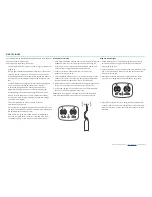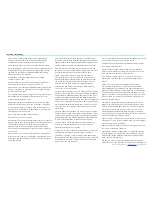
For more product information visit |
www.FatShark.com
| All Rights Reserved
Common Terminology
•
Acro mode- A neutrally stable flight mode, when a drone
is flying in this mode it will try to retain the attitude it was
commanded to when the pitch/roll stick is centered.
• Active braking- A feature in electronic speed controls where
motor braking is part of the control system. Decelerating motors
as part of the control loop has a distinct advantage; It causes
the motors to reach the commanded RPM quicker, making
stability and control more precise.
•
Analog video- CVBS video signal that is not encoded,
commonly used for FPV.
•
Attitude- Refers to the position an aircraft is in; it describes
what angle the aircraft is occupies in pitch and roll.
•
Attitude mode- An Inherently stable flight mode, when a drone
is flying in this mode it wants to return to level flight when the
pitch/roll stick is centered
•
ATV- Amateur television, the category of activity in the amateur
radio hobby that RC hobbyists use to gain legal access to
wireless video frequencies for FPV.
•
Bank angle- The angle or attitude an aircraft occupies. Bank
angles are referenced off the horizon, level flight is 0 degrees.
•
Bi, Tri, quad, penta, hex, etc copter- refers to the number of
propellers on a multicopter. A bicopter has two, a tricopter has
three, a quadcopter has four, etc.
•
Bin file- Raw data file that contains firmware.
•
BLHeli- open source ESC firmware
•
Brushed motor- Uses mechanical means (brushes) to transmit
electrical power from the power leads to the spinning armature.
The Armature contains coils of wire which act on the fixed
magnets in the case. The coils make contact with brushes
which supply voltage during appropriate intervals to cause the
motor to spin.
•
Brushless motor- Uses 3 phase (half) AC power from the ESC
to cause a motor to spin by switching the magnetic field in the
windings on and off and correct intervals to cause the magnet
on the shaft to spin.
• CCD- sensor that are full frame capture which makes them
immune to prop vibration distortion and generally have better
light handling as the imager is fully dedicated to light capture.
• Channel- Refers to a single command from the control stick.
Each command occupies one channel. Roll, pitch, yaw, and
throttle each occupy a single channel. Flight modes, motor cut,
and similar features all occupy a single channel each.
• CMOS- Image sensors used for video cameras that use
processing on the sensor, thus cheaper to produce. CMOS
typically generate an image by scanning top to bottom and
can be subject to jello image from prop vibration. Industry
development is pushing CMOS so the performance gap
between CCD and CMOS is diminishing. CMOS is the only
solution for micro sized cameras.
• Common frequencies for control- 2.4 GHz is the most common
frequency for all types of RC control. Some extreme hobbyists
also dabble with 433MHz, 900MHz and others for FPV. Each
frequency has different advantages and disadvantages, and
different legalities worldwide. For the vast majority of hobbyists,
2.4GHz control is the right choice and will have sufficient range
with sufficient bandwidth to enable 100+ aircraft to fly at the
same time. Be sure to research legal operation locally before
transmitting.
• Common frequencies for video- 5.8 GHz is the most common
frequency for FPV. Other frequencies include 900MHz, 1.3 GHz,
2.4GHz and 3.3 GHz. Each frequency has different advantages
and disadvantages, and different legalities worldwide. Be sure
to research legal operation locally before transmitting.
• Computer radio- Transmitter that has a small screen with
buttons or programming wheel, etc to enable the user to
manipulate settings in the controller.
•
Configurator- A piece of software that enables a user to set up
and configure settings and features in flight controllers.
•
CP antenna- commonly used for 5.8 GHz video applications,
these antennas work best when paired with other CP antennas,
and have better multipath rejection than linear as the signal
polarity reverses when reflected.
•
Cyclic- A term primarily associated with helicopters, cyclic refers
to the fore-aft and side to side tilt of the aircraft
•
Damped light- Popular active braking feature found in BLHeli
• DVR- Digital Video Recorder
•
Elevator, aileron, rudder- Terms carried over from airplanes,
elevator controls the pitch of the aircraft, aileron controls the
roll of the aircraft and rudder controls the yaw.
•
ESC- Electronic Speed Control, a circuit which connects to
battery power and the flight controller and manages motor
speed.
•
Field of view(FOV), camera and headset: Field of view
describes how wide the view is in the camera and headset.
When talking about a camera FOV, the angle describes how
wide the camera will see. When talking in terms of the headset
FOV, the angle describes how large the screen appears. A very
large FOV would be similar to sitting in the front row of a movie
theatre, while a very small FOV is similar to watching a small
television from a distance.
•
Firmware- Programming code that determines how circuits
behave. Firmware code includes calculations and instructions
which is the operational heart of every circuit with microchips.
•
First person vs 3rd person RC flying- First person RC is FPV
where the pilot experiences the vehicle through a video feed
from the first person perspective. 3rd person RC is conventional
where the operator watches the vehicle.
• Flight Controller- The microcomputer on-board an aircraft that
accepts sensor input (gyros, accelerometers, etc), and manages
motor speed to control an aircraft.
• Flight envelope- Describes the limits of an aircraft such as how
fast, how maneuverable, stable, etc
•
Flight Modes- Different configurations to enable the model to
respond differently to control stick inputs. Differences in flight
modes might include a different stabilization mode, different
rates, control mixes, lights, etc.
•
Flip and roll- A flip is a forward or backward rotation about a
horizontal axis, a roll is a rotation to the side about a lengthwise
Содержание 101
Страница 1: ...DRONE TRAINING SYSTEM ONLINE MANUAL V 2 0 ...































